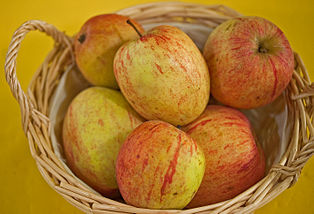Prince's apple
| Real prince's apple | |
|---|---|
| Synonyms | Bottle apple, Hasenkopp (Berlin, Northern Germany), Immerträger, Katzenkopf, Nunentitte, Schlotterapfel |

|
|
| Art | Cultivated apple ( Malus domestica ) |
| origin | very likely northern Germany |
| known since | 1780 |
| List of apple varieties | |
The 'real prince's apple' is an old variety of the cultivated apple ( Malus domestica ), which belongs to the group of the prince's apples. The fruits are ripe for picking from the end of September, while they are ready for consumption from October. In nature storage they can be kept until January.
designation
The real prince's apple is a very old apple variety for which there are different names :
- 'Pineapple' (Württemberg),
- 'Donut',
- 'Brienzer' (Switzerland),
- 'Bottle apple' (Norway, East Prussia),
- 'Bell Apple' (Bavaria, Rhineland),
- 'Gugeliapfel' (Switzerland),
- 'Oat apple',
- 'Haierapfel' (Westphalia),
- 'Hasenkopp' (Northern Germany),
- 'Bunny nose',
- Ibersheim Prinzenapfel
- 'Immerträger',
- 'Jerusalemapfel' (Detmold),
- 'Cat's Head',
- 'Klapperapfel',
- 'Melonenapfel' (Bavaria, Rhineland, Hanover);
- 'Nun's apple',
- 'Red-striped Schlotterapfel' (Baden-Württemberg),
- 'Trumpeter Apple',
- 'Walzenapfel' (Baden).
fruit
The 'Echte Prinzenapfel' is a medium-sized to large, cylindrical, fairly evenly built apple. It has medium-thick ribs that flatten towards the center of the fruit. The fruit peel is smooth, matt-glossy and yellowish green, light yellow when ripe. The sunny side of the fruit is often reddened and streaked. The smell of the peel is clearly reminiscent of pineapple .
The “pulp” is yellowish white, relatively fine and juicy; it has a pleasant acidity with a sufficiently high sugar content. The prince's apple has a typical fruity taste with fine spice. The fruit tends to wither on the bed. It must therefore be stored in a cool and humid place.
tree
The 'prince's apple' needs moist and nutritious soil . It is well suited for growing in coastal areas . It tolerates harsh locations and also thrives in higher mountain regions up to 800 meters. Since the side shoots sprout poorly, the leading shoots have to be cut back regularly for several years. The 'Prinzenapfel' is suitable for higher tree forms, but is not suitable for string systems and trellises due to its growth characteristics . The harvest of the 'Prinzenapfel' starts early and is regular. The tree can get very old, but older trees are prone to cancer . The late flowering period is insensitive to the weather .
Rattle apple
The Hasenkopp is nicknamed "Klapperapfel" because the kernels of individual specimens lie loosely in the case and can be heard rattling when shaken vigorously.
Web links
- Index card of the variety in the BUND-Lemgo fruit variety database
Individual evidence
- ^ State capital Potsdam (ed.): Fruit Atlas of the Russian Colony Alexandrowka in Potsdam: A pomological guide. Potsdam 2012, p. 152.
- ^ State capital Potsdam (ed.): Fruit Atlas of the Russian Colony Alexandrowka in Potsdam: A pomological guide. Potsdam 2012, p. 152.
- ↑ a b c F. Jahn, E. Lucas, JGC Oberdieck: Illustrirtes Handbuch der Obstkunde First volume: Aepfel , Ebner and Seubert, Stuttgart 1859, No. 13, p. 57.
- ↑ a b c d W. Lauche: German Pomology: Chromolithographic illustration, description and culture instructions of the most recommendable varieties of apples, pears, cherries, plums, apricots, peaches and grapes. Published by Paul Parey, Berlin 1882, No. 26.
- ^ A b David Szalatnay, Andrea Frei: How a German prince became a beautiful Englishman. Swiss Journal for Fruit and Viticulture 15/2009, pp. 11–13. Archived copy ( memento of the original from January 24, 2016 in the Internet Archive ) Info: The archive link was inserted automatically and has not yet been checked. Please check the original and archive link according to the instructions and then remove this notice.
- ^ AFA Diel: Attempt to systematically describe the pome fruit varieties available in Germany , Second Booklet Apples, Andreaische Buchhandlung, Frankfurt am Main 1800, pp. 130ff.
- ↑ Advice center for fruit and vegetable growing at the Worms District Office: Fruit range for the Worms district, 1952
- ↑ Noble fruit grower Otto Dahlem (* 1872 Ibersheim)
- ↑ http://www.worms.de/de/kultur/stadtgeschichte/wüsten-sie-es/liste/2012-05_ibersheim-prinzenapfel.php
- ↑ JG Dittrich: Systematic manual of fruit science, together with instructions for fruit tree cultivation. First volume: pome fruits. Published by Friedrich Mauke, Jena 1837, No. 49, p. 143.
- ↑ J.-H. Rolff: The apple - variety names and synonyms. BoD, 2001, p. 319
- ↑ Ruth Buder: The "Hasenkopp" can rattle In: Märkische Onlinezeitung from September 16, 2016.
- ↑ Audio sample on YouTube (poor quality)
